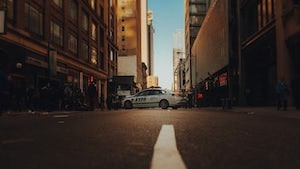Since 1993
“Pull Over Immediately”: Why Hesitation Can Cost You Your Freedom (and Your BMW)

By: John Guidry
Think back to elementary school. Didn’t we all have that mean gym teacher who “demanded” you obey his commands, or else—ten push-ups? That same demand for “Immediate Compliance” applies when an officer turns on the dreaded flashing blue lights. We must instantly pull over—or it’s a crime.
The crime of “not pulling over as soon as an officer thinks you should” is known as Fleeing or Attempting to Elude (FATE). Conceptually, it is simply a trumped-up “Resisting Without Violence.” But legally? It is a nightmare.
- Then: When I started in 1993, this was often a misdemeanor.
- Now: It is always a Felony.
Did you panic when you saw the blue lights?
Hesitation is not a crime. Call John today at (407) 423-1117.
The Penalties: No Mercy, No Withholds
Fleeing charges (Florida Statute 316.1935) are unique because the legislature has removed almost all leniency.
- No Withhold of Adjudication: Just like a DUI, the judge cannot withhold adjudication. If you plead to this, you will be a Convicted Felon.
- Forfeiture: The car used in the chase is deemed “contraband.” So, your $70,000 BMW can be seized by the Sheriff just because you didn’t pull over fast enough.
The Levels of Punishment:
- Basic Fleeing (Lights/Sirens): 3rd Degree Felony (Max 5 Years Prison).
- High Speed / Reckless Fleeing: 2nd Degree Felony (Max 15 Years Prison).
- Fleeing Causing Injury/Death: 1st Degree Felony (3-Year Minimum Mandatory Prison Sentence).
Defense #1: The “Markings” Technicality (Slack v. State)
So, how do we defend these? We look at the police car. The statute requires the officer to be in an “authorized law enforcement patrol vehicle with agency insignia and other jurisdictional markings prominently displayed.”
The Case: Slack v. State (2010)
- The Facts: The officer testified he was in a “marked patrol car” with lights on top.
- The Problem: Being “marked” isn’t enough. The officer failed to prove the car had Agency Insignia (like a Sheriff’s Star) prominently displayed.
- The Result: Conviction Overturned. (See also Gorsuch v. State: A “City of Miami” seal on the door wasn’t enough without lights/sirens activated).
Defense #2: Necessity (The Pregnant Driver)
Can an emergency drive to the hospital be a defense? Yes. We call this the Necessity Defense.
- The Example: A pregnant woman rushing to the hospital due to complications refused to stop. She was arrested but eventually won her case.
- The Requirement: You must prove the emergency was “Real, Imminent, and Impending” and that you had no other choice but to keep driving.
Defense #3: The “Illegal Stop” Paradox (State v. Kirer)
Here is where the law gets weird. Normally, if a cop stops you illegally, the evidence is thrown out (“Fruit of the Poisonous Tree”). But not for Fleeing.
The Case: State v. Kirer (2013)
- The Facts: Kirer drove away from a “suspicious incident” at a vacant house. He obeyed all traffic laws (didn’t speed, didn’t run stop signs).
- The Stop: The police had no legal reason to pull him over.
- The Ruling: The Court ruled that even if the stop was illegal, Kirer committed a new crime by not stopping.
- The Logic: You do not have the right to flee an illegal stop. If you run, you validate the arrest.
John’s 2026 Update: StarChase & Remote Kill Switches
Note: In 2010, you could outrun a Crown Vic. In 2026, you can’t outrun the GPS.
1. The “StarChase” Dart Police pursuits are dangerous. In 2026, many departments use GPS Projectiles (StarChase).
- The Tech: Instead of chasing you at 100mph, they shoot a sticky GPS tracker onto your trunk. They turn off their lights, let you think you got away, and then arrest you when you park at home.
- The Defense: This kills the “Reckless Driving” enhancement. If the cops stopped chasing you, you likely slowed down. We argue to reduce the charge from a 2nd Degree (15 years) to a 3rd Degree (5 years).
2. “Remote Kill” Warrants Newer vehicles (2024+) often have OnStar-style remote shutdowns.
- The Trend: Police can subpoena the manufacturer to shut off your engine remotely during a chase.
3. The “Unmarked” Trap We see more “Ghost Graphics” (stealth markings) on police cars.
- The Argument: We argue Slack v. State even harder now. If the markings are “Ghost” (reflective only at night), are they “Prominently Displayed” during the day? We argue No.
Don’t turn a Traffic Ticket into a Felony
If you see the lights, stop. If you didn’t stop because you were scared or didn’t see them, we can fight the felony. But don’t try to outrun the radio.
Call me at (407) 423-1117. Let’s analyze the dashcam.

About John Guidry II
John Guidry II is a seasoned criminal defense attorney and founder of the Law Firm of John P. Guidry II, P.A., located in downtown Orlando next to the Orange County Courthouse, where he has practiced for over 30 years. With more than three decades of experience defending clients throughout Central Florida since 1993, Guidry has successfully defended thousands of cases in Orange, Seminole, Osceola, Brevard, Lake, and Volusia counties. He has built a reputation for his strategic approach to criminal defense, focusing on pretrial motions and case dismissals rather than jury trials.
Guidry earned both his Juris Doctorate and Master of Business Administration from St. Louis University in 1993. He is a member of the Florida Bar and the Florida Association of Criminal Defense Lawyers. His practice encompasses the full spectrum of Florida state criminal charges, with a particular emphasis on achieving favorable outcomes through thorough pretrial preparation and motion practice.
Beyond the courtroom, Guidry is a prolific legal educator who has authored over 400 articles on criminal defense topics. He shares his legal expertise through his popular YouTube channel, Instagram, and TikTok accounts, where he has built a substantial following of people eager to learn about the law. His educational content breaks down complex legal concepts into accessible information for the general public.
When not practicing law, Guidry enjoys tennis and pickleball, and loves to travel. Drawing from his background as a former recording studio owner and music video producer in the Orlando area, he brings a creative perspective to his legal practice and continues to apply his passion for video production to his educational content.








